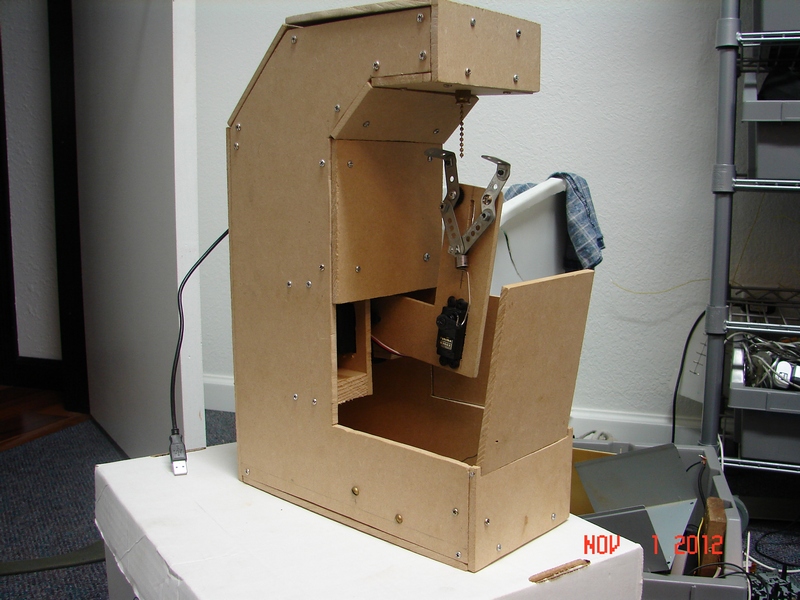The mechanical simplicity of this pull-string controlled most useless machine is delightful. You can see the metal gripper which is reaching up to tug on a light-fixture-style pull chain. This is how it turns itself off after you’ve pulled the string to power it up.
The device is [Alex555’s] entry in the 7400 Logic competition. We do hope that he ends up posting a schematic because we’d love to see the gritty details of how it works. After the break you can watch two doors open, allowing the arm to raise up and the gripper to grab the chain. This takes just four servo motors, which are controlled by the signal from a 555 timer and some accompanying hardware.
Apparently the chain is a fake, as the servos didn’t provide enough force to actuate that type of switch. It’s not a surprise as those pull chains do require quite a tug. An optical sensor was used to trigger the movement when your hand reaches for the chain.
[Thanks Brett]















If it’s fake, it’s no fun…
My first thoughts were FAIL because it couldn’t actually pull the chain, but after watching the video I say WIN. I like the multi-step process of each of the doors opening, the arm coming up and the gripper opening.
Instead of the sensor, I would have just used a different type of switch, like a momentary switch or an optical switch itself.
I like it but I feel like it’s too complicated. “Pulling” the chain simply sets off a new set of routines. In the typical useless machine you flip a switch to turn it on. It then reaches out to turn itself off. The simple process of cutting power to itself rests itself inside it’s box, not trigger a new routine to turn off.
Still, mechanically, it’s very cool. Way to go!
I don’t understand your argument. you pull the chain to turn it on, and it pulls the chain to turn itself off. It’s still the same process.
What he means is, the action of losing power resets the device in a normal useless machine.
In this one, pulling the chain merely sets off more events that eventually leads to being off. The elegance of the machine resetting when the power is turned off has been lost.
If a normal machine turned off power to itself when it hit the switch, it wouldn’t retract back into the box.
On a basic machine, you turn the switch on, sending current to a motor which pushes the finger out and flips the switch off. Once the motor loses power, a spring pulls the finger back in.
It doesn’t really matter though. The more complicated you make them, the more useless they become.
I don’t understand. The picture shows a machine the size of an arcade cabinet and the video shows a table top model.
They’re the same machine. Look at the USB cable for reference on the first one.
Did you honestly think I was serious?
I was making a sarcastic comment about the strange persecutive in the first photo.
@Nunya Bidness
So it was the most useless comment on the most useless machine?
Could we not, in honor of the designers of the original device, use the original name for these designs: “The Ultimate Machine”?
I strongly support that.
I’m not sure if I agree with the sentiment that this is “mechanical simplicity”. The original useless machine is much more mechanically simple.
I’ve got a Windows 8 box that I’d like to enter into the most useless device contest…
I would suggest that instead of an optical sensor, a simple pushbutton or microswitch could have easily provided a low-pull switch for the chain.
You just need to pull the right strings to get what you want…
don’t know why, but I love these idiotic useless machines!